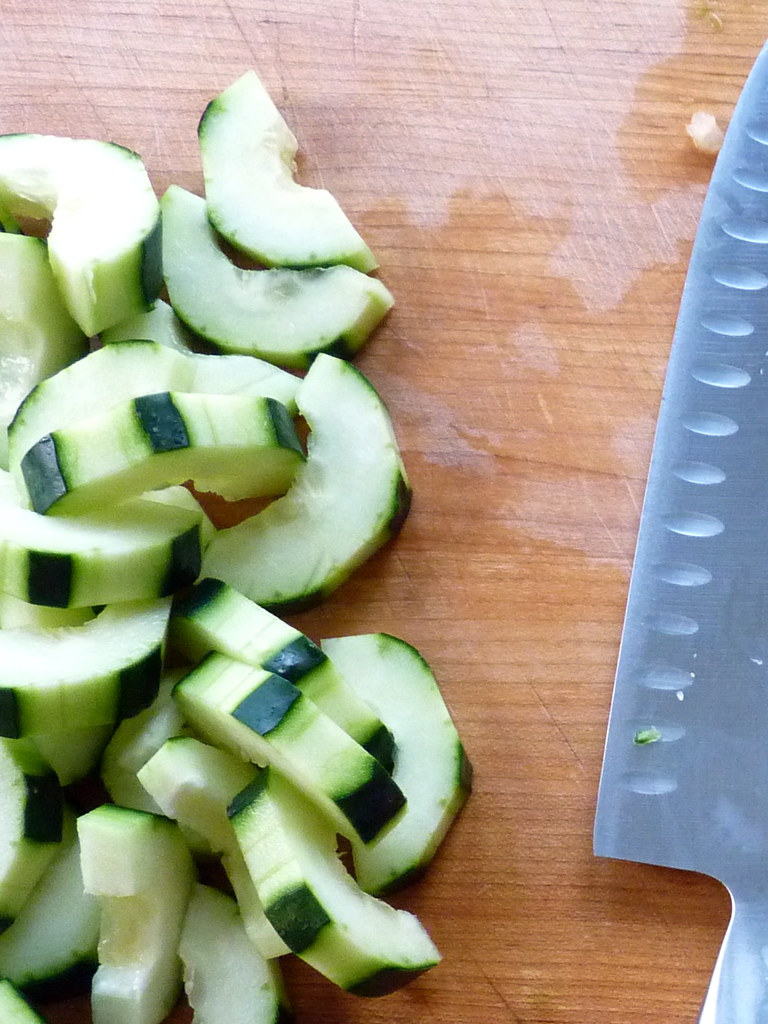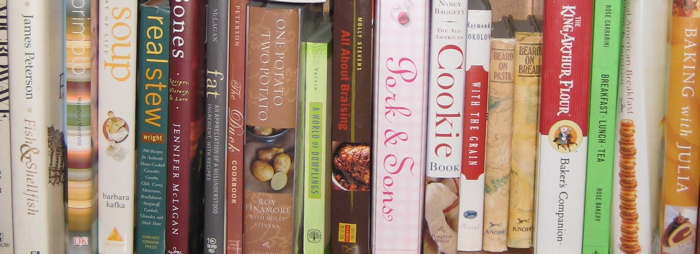After I was freed from the prohibitions of thesis writing, I continued to buy cookbooks. Since I was gainfully employed, I no longer depended on used bookstores, mega-mart cut-out bins, and promotional discounts from The Good Cook. I could buy whatever cookbooks I wanted. By the time Ann and I went on to the market for a home in Haverford, it became clear that we not only needed a bigger kitchen for cooking, we needed a bigger house for storing cookbooks. Ann’s father, Newt, made us bookshelves for the dining room, and I filled it, and then a second. I thought I would stop there, but I already find myself keeping books “in circulation,” out on the dining table, in the kitchen, by the fireplace, or in my office, because I can’t get them all on the shelves at the same time.
My mother thinks my cookbooks and eating habits are decadent. When she says “decadent” she doesn’t mean decadent as in “Oh, isn’t this flourless chocolate cake decadent.” She means fall of Rome decadent. I told her all about this weekend’s Christmas party at Saint Joseph’s University, co-catered by Ann and Madame Fromage with all her wonderful cheeses. And there was that word again, decadent. I think she imagined me sitting at a table eating Delice De Bourgogne and Trugole with my head under a napkin, like Francois Mitterrand eating songbirds. (It is said that Ortolan eaters cover their heads not just to capture the aroma of these thumb-sized tweeties, but also to hide their shame from God).
Mom may have a point. I wasn’t raised this way. I didn’t acquire these indulgences from my parents. Its part self-indulgence and part simply the changing state of the gourmet food “empire”. Cheese is the perfect example. We grew up with cheddar, jack, and swiss and most of us didn’t like swiss. “Brie” was adult food, slightly repellent and as much a status symbol as steak was in the 50s. I was born in 1971, the same year as Chez Panisse, the first restaurant to serve goat cheese on salads. Now, even our local Trader Joe’s has started carrying Valdeon, a cow and goat’s milk bleu cheese wrapped in sycamore leaves. According to Steven Jenkin’s Cheese Primer, when Dean and Deluca got started in 1977, there were no authentic European cheeses in the U.S. But now? I’ve never stepped foot in a cheese store, but I’ve bought Basque de Bleu, Joyeaux, and Idiazabal one small slice at a time from the farmer’s market in Ardmore. Who knows? Maybe one day soon, even something like Madame Fromage’s Cheese Creche will no longer seem unusual or eccentric, just sacrilegiously tasty.
That said, few of my cookbooks are really about voluptuary excess. Most are about serving good food simply, healthily, and ethically. The more complicated recipes are less about how much you pay for food, and more about how much time you pay in deference to the food. When I get new books, I insist that they must be “useful,” in some fashion, though I admit my definition of utility has been growing as quickly as my collection. One Marcella Hazan cookbook, for example, is very useful for cooking Italian, but I suppose it isn’t four times as useful to own four of them. Everyone should probably have Chinese, Spanish, Italian, and French cookbooks, but no one needs a Swedish cookbook unless they think fish pairs well with the flavors of lye or birch ash. Even if I am Swedish, I recommend against food that comes with warnings about poisoning or “saponification” (If Lutefisk is soaked for too long, the fish fat literally turns to soap). But I read Swedish cookbooks the way priests read heretical texts, so that I can better understand the enemy.
I use the Larousse Gastronomique very little, but in my defense I bought it scandalously cheap from a used bookstore on the main line. Its harder to explain Ali-Bab’s Encyclopedia of Gastronomie, which I bought for its footnotes on cannibalism. I will probably never make a dish from The Fat Duck cookbook, even if I had the equipment necessary for molecular gastronomy. One Heston Blumental recipe, for example, describes a Christmas themed dish, where an “ingot” of frankincense bullion is wrapped in gold leaf. The diner is supposed to dissolve the bullion in water by stirring it with a myrrh branch. The same page refers to a communion wafer “infused with the smell of a baby” designed by perfumer Christophe Laudamiel to accompany the equally creepy movie Perfume. I suspect even a devout transubstantiationalist would agree that wafer shouldn’t taste like Jesus, and even if it did, it shouldn’t taste like him as an infant. I’d much rather eat my way through a cheese crèche than this kind of strangeness, but how can one resist a cookbook that talks about such things? That is illustrated by comic book artist Dave McKean? Entertainment is a utility, too. As is gawking at carnival freak shows.
(For more gawking, See Heston Blumenthal’s “Perfect Christmas Dinner” video).
I have however come to terms with any embarrassment coming from my cookbook addiction. It was all put aside when I visited Fritz Blank’s restaurant with Ann and my parents a couple of years ago. My parents were visiting during their anniversary, and I steered them toward dinner at Deux Cheminees, a restaurant as well known for its cookbook library as it was for its food. The French restaurant was a little too elegant, even for a closet Petronius like myself. It required men to wear coats and ties. It made you worry about your pronunciation of French dishes and which fork you used to eat the salad. But mostly what I remember was the quiet. It was like the eerie episode of Buffy, “Hush,” with no dialogue, just eerie waiters gliding between tables, putting pepper on things and silently disappearing back into the kitchen.
The food was great, but I prefer to eat where diners can share plates at the table, or even with an adjoining table, and not get the other patrons hackles up. In fact, I prefer to avoid restaurants with “patrons” even if they don’t have hackles. I like diners, customers, and other grubby individuals who lick their fingers while they eat. But it was well worth going for the opportunity to sneak off to the library. The room was hidden away from the carefully constructed scene in the dining room. It was in an unadorned hallway, behind a door that might as easily have led to a broom closet or a boiler room. I felt like an intruder, so I didn’t turn the lights on. I just stood with Ann and my parents on the promontory, trying to make out the titles on the wall of books visible from the hall.
We probably wouldn’t have ventured further in, if not for Bobo. Most people don’t know this, but Ann is often shy around strangers. She is talkative out of a sense of obligation or duty, but she only has a natural affinity for talking to pet owners. If she sees a cat, she’ll follow it until she finds its owner. And she’ll strike up a conversation regardless of whether the owner is a neighbor or a stranger, a catholic nun or an ex-IRA bomber, or—as it turns out—a two star Michelin chef named Fritz.
Bobo the cat came out of the cavernous dark to greet us, rubbing up against Ann’s legs. We followed Bobo in past one dark bay after another filled with cookbooks, cookbooks, and more cookbooks. The room was long and narrow, like one aisle of the warehouse in Raider’s of the Lost Ark. It seemed to go on forever, but eventually ended in a pool of light, where we found Fritz Blank himself taping up a box of books. Wearing a black t-shirt and jeans, he was probably the only comfortable person in the establishment. But sadly, he was packing up for good. Having run Deux Cheminees since the 1970s, he was retiring to Thailand and taking little with him other than Bobo. Most of his restaurant’s belongings would be liquidated—sold off to customers—including many of his books, with the exception of the 10,000+ that were being sent to the UPenn library as a permanent collection.
I’ve always wanted to go to a restaurant sale, so I’m sad I missed that one. Who knows? I could’ve added to my book collection, or finally bought a copper saucepan or pot. I could put white figurines in my living room and start referring to my own cats as “patrons”. But I have no regrets because we had one of the last grand tours of the library before it was dismantled. Even my parents got to get in on the fun, because Chef Fritz took an interest in their genetics background. Turns out he was a microbiologist for the military before he turned to the restaurant business. He told us stories of his days in Southeast Asia, and his current designs for a cookbook constructed around the appetites of musical composers. While doing so, he showed us the ins and outs of a collection that contained everything from a “1627 banquet book written by a papal household steward” to a “2001 Hooter’s pocket menu and cooking menu for Navy cooks”.
This was one of my favorite nights out, even though I don’t remember what I ate. It was here that I finally understood: here was a guy who owned thousands of cookbooks, a guy who also had a collection of chicken stock cans that would cause any shrink to diagnose him as a hoarder, and yet he seemed positively buoyant even as he was giving it all up. So why should I feel any different? I’m not an Ortolan eater or an omen of a falling empire. I’m just a collector who still has a long, long way to go.





